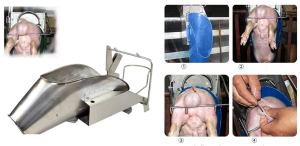FA youngstock processing
Piglet castration
In the USA, pigs are castrated at a young age to avoid boar taint, a slight odor/taste to meat. In Europe, many food buyers will not buy castrated pigs but they sell pigs at a younger age/lighter weight and are more used to the flavor difference.
Piglets are almost always castrated using an open technique and using manual traction to remove the testicle.
The same reasons for early castration of calves also apply to pigs: castrate young animals for easier restraint and handling, fewer complications and minimal impact on pig weight gain, etc. Piglets are generally castrated 4-14 days of age. This avoids the first few days when they are absorbing colostrum, makes it easier to identify inguinal hernias, and is still well before weaning. Piglets should be castrated at least 5 days prior to weaning to minimize the risk of combined stressors.
The industry standard is changing to encourage local anesthesia as part of pig castration. Lidocaine can be administered intra-testicularly. Adult pigs are NOT very sensitive to lidocaine with a high dose of 8 mg/kg but neonates will be more sensitive. Meloxicam is secreted through the sows milk so feeding meloxicam to the sow at least 3 hours prior to castration would add analgesia and prevent windup.
Producers can buy devices to help restrain the piglets with minimal stress or additional trauma:

These are sized for young piglets so also encourage appropriate castration timing.
Piglet castration steps. VA Cooperative Extension:
Castration Method for One Person Using a Surgical Knife (adapted from PIH 01-01-07)
|
1. |
Hold the piglet by both hind legs with its head down. |
|
2. |
Using the thumb, push up on both testicles. |
|
3. |
Make an incision through the skin of the scrotum over each testicle in the direction of the tail. |
|
4. |
Be sure the incisions are made low on the scrotal sac to allow for fluid drainage. |
|
5. |
It does not matter if you cut through the white membrane of each testicle or not. |
|
6. |
Pop the testicles through each incision and pull on them slightly. |
|
7. |
Pull each testicle out while pressing your thumb against the piglet’s pelvis. |
|
8. |
Thumb pressure on the pelvis is important to ensure that the testicular cords break off at the point of your thumb rather than deep inside the body, which may promote development of a hernia. |
|
9. |
If necessary the testicle may be cut free of the cord using a scraping motion. |
|
10. |
Cut away any cord or connective tissue protruding from the incision and spray the wound with antiseptic. |
Youtube video showing piglet castration
Key Takeaways
Piglets should be castrated at a young age, using analgesics and local anesthesia
Pigs are prone to inguinal hernias; waiting until at least 4 days of age enhances identification of problem pigs.
Resources
Bates et al. Impact of Transmammary-Delivered Meloxicam on Biomarkers of Pain and Distress in Piglets after Castration and Tail Docking-2014, PloS One
JF Coetzee et al. Transmammary delivery of firocoxib to piglets reduces stress and improves average daily gain after castration, tail docking, and teeth clipping. Journal of Animal Science, Volume 97, Issue 7, July 2019, Pages 2750–2768,
Skelton JA et al. Cryptorchidectomy with a paramedian or inguinal approach in domestic pigs: 47 cases (2000–2018). J Am Vet Med Assoc 2021;258:1130–1134

